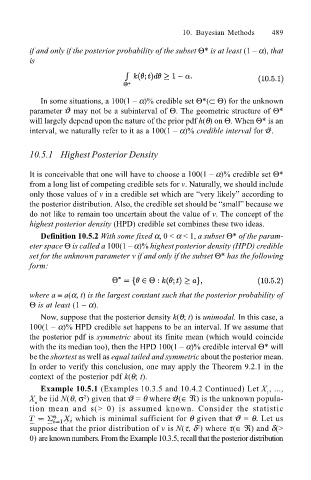Page 512 - Probability and Statistical Inference
P. 512
10. Bayesian Methods 489
if and only if the posterior probability of the subset Θ* is at least (1 α), that
is
In some situations, a 100(1 α)% credible set Θ*(⊂ Θ) for the unknown
parameter may not be a subinterval of Θ. The geometric structure of Θ*
will largely depend upon the nature of the prior pdf h(θ) on Θ. When Θ* is an
interval, we naturally refer to it as a 100(1 α)% credible interval for .
10.5.1 Highest Posterior Density
It is conceivable that one will have to choose a 100(1 α)% credible set Θ*
from a long list of competing credible sets for v. Naturally, we should include
only those values of v in a credible set which are very likely according to
the posterior distribution. Also, the credible set should be small because we
do not like to remain too uncertain about the value of v. The concept of the
highest posterior density (HPD) credible set combines these two ideas.
Definition 10.5.2 With some fixed α, 0 < α < 1, a subset Θ* of the param-
eter space Θ is called a 100(1 α)% highest posterior density (HPD) credible
set for the unknown parameter v if and only if the subset Θ* has the following
form:
where a ≡ a(α, t) is the largest constant such that the posterior probability of
Θ is at least (1 α).
Now, suppose that the posterior density k(θ; t) is unimodal. In this case, a
100(1 α)% HPD credible set happens to be an interval. If we assume that
the posterior pdf is symmetric about its finite mean (which would coincide
with the its median too), then the HPD 100(1 α)% credible interval Θ* will
be the shortest as well as equal tailed and symmetric about the posterior mean.
In order to verify this conclusion, one may apply the Theorem 9.2.1 in the
context of the posterior pdf k(θ; t).
Example 10.5.1 (Examples 10.3.5 and 10.4.2 Continued) Let X , ...,
1
2
X be iid N(θ, σ ) given that = θ where (∈ ℜ) is the unknown popula-
n
tion mean and s(> 0) is assumed known. Consider the statistic
which is minimal sufficient for θ given that = θ. Let us
suppose that the prior distribution of v is N(τ, δ ) where τ(∈ ℜ) and δ(>
2
0) are known numbers. From the Example 10.3.5, recall that the posterior distribution

